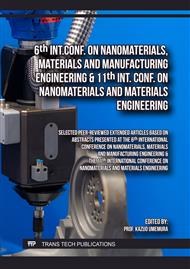p.45
p.51
p.59
p.67
p.75
p.81
p.87
p.95
p.101
Electrowetting Behavior of Water Microdroplets on a Natural Superhydrophobic Leaf and its Elastomeric Replica
Abstract:
Investigating the electrowetting behavior of droplets on structured surfaces provides insight in developing electric-driven microfluidic substrates and membranes. Microstructures and patterns inspired by nature could result in interestingly unique wettability and electrowetting phenomenon. In this work, the electrowetting of water droplets on a superhydrophobic leaf of desmodium (Desmodium spp) and its elastomeric replica were explored. An open electrowetting system consisted of an optical camera, platinum wire, and DC power supply with water microdroplets as test liquid was used to investigate the electrowetting behavior on the leaf. Soft lithography using elastomer was used to produce replica of the leaves. Natural cell-like patterns, including central protrusions and microhairs, contribute to the leaf's superhydrophobic properties (contact angle > 150°). The negative copy of the natural patterns generated via soft lithography produced a microstructured elastomeric film, showing a static contact angle of ~128°. Optical microscope images of the elastomeric copy revealed the successful duplication of the leaf’s surface features. Subsequent electrowetting experiments demonstrated a contact angle reduction of up to 15° and 9.5° for the natural leaf and its elastomeric replica, respectively. A pronounced electrowetting-driven droplet motion was observed on the leaf while droplet pinning was noted in the elastomer. These results offer new insights into the electrowetting phenomenon of microstructured surfaces for potential self-cleaning and water-trapping applications.
Info:
Periodical:
Pages:
95-100
Citation:
Online since:
March 2025
Price:
Сopyright:
© 2025 Trans Tech Publications Ltd. All Rights Reserved
Share:
Citation:



